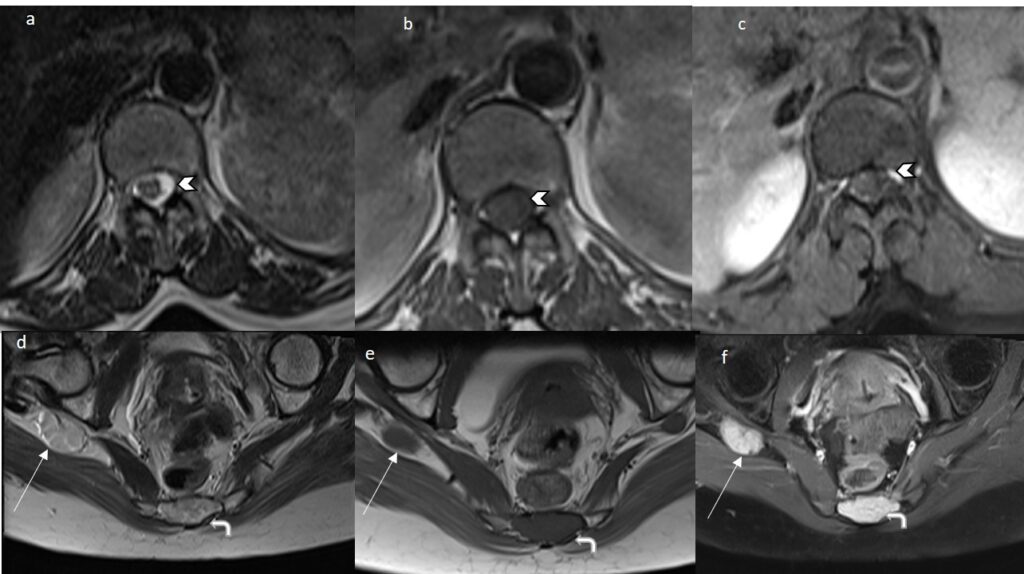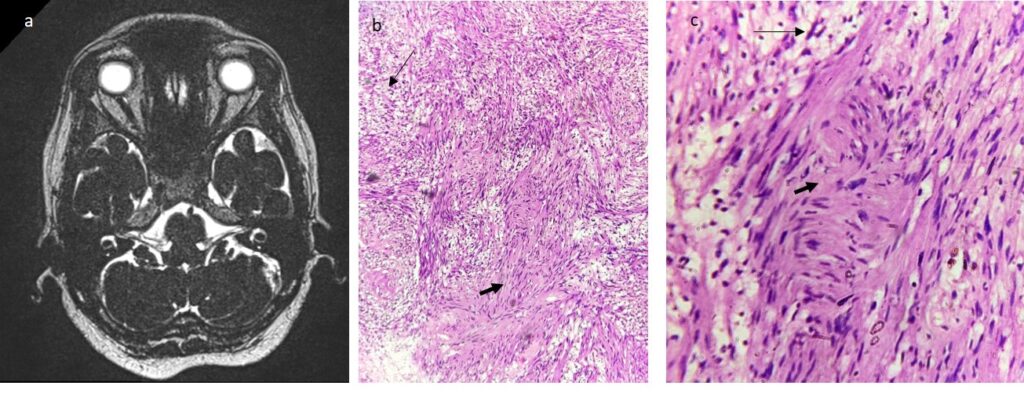Ritu Sharma1, Suresh Kumar2*, Sandeep Moudgil1, Anupam Jhobta1
1Department of Radiodiagnosis, IGMC, Shimla, Himachal Pradesh, India
2Associate Professor Neuroradiology, Department of Radiodiagnosis, IGMC, Shimla, Himachal Pradesh, India
*Corresponding Author: Suresh Kumar, Associate Professor Neuroradiology, Department of Radiodiagnosis, IGMC, Shimla, Himachal Pradesh, India; Email: [email protected]
Published Date: 24-06-2021
Copyright© 2021 by Kumar S, et al. All rights reserved. This is an open access article distributed under the terms of the Creative Commons Attribution License, which permits unrestricted use, distribution, and reproduction in any medium, provided the original author and source are credited.
Abstract
Schwannomatosis is rare neurocutaneous disorder. It is characterised by multiple schwannoma without involvement of vestibular apparatus. Being genetically different from NF2, now considered third form of neurofibromatosis. Imaging plays an important role in diagnosing schwannomatosis and helps in differentiating it from NF2.
Keywords
Neurocutaneous Disorder; Knee Joint; Pain; Tumor
Introduction
Schwannomas are benign peripheral nerve sheath tumors occuring sporadically in NF2 and in Schwannomatosis. Schwannomatosis shows the presence of multiple schwannoma without involvement of cranial nerve VIII [1]. It is a disorder with unknown prevalence [2,3]. Peak incidence occurs between 30-60 years of age1. Its diagnosis requires exclusion of NF2. For definite diagnosis of schwannomatosis, age should be more than 30 and presence of 2 or more non intradermal schwannoma (one histologically proven) [4]. Unlike NF2, disabling pain is the usual presentation in these patients. We report a case of 40-year-old female who presented with low backache for 3 months.
Clinical Details
A 40 Years old female presented to the orthopaedic department with low backache for the last 3 months and radiating to left lower limb for the last 12 days. Pain was insidious in onset, gradually progressive and moderate in intensity. There was no history of trauma, cough, or fever. There was no history of similar complaints within the family. On examination, no swelling, scar marks and no sinus seen but tenderness was present over lumbar spine region corresponding to L2, L3 and L4 vertebrae.
There were no subcutaneous nodules, no axillary freckling, no café-au lait spots.
On ophthalmological examination, no evidence of cataract and lisch nodules seen.
On neurological examination, power was reduced (3/5) in left hip joint, left knee joint (during flexion). B/L knee and ankle jerks were brisk (3+). Bladder and bowel movements were normal. B/L DPA were palpable.
For further workup MRI of whole spine was done which revealed altered signal intensity (T1 hypointense, T2 heterogenously hyperintense, STIR hyperintense) intradural extramedullary lesion showing post contrast enhancement seen involving sacral canal region extending to involve the sacral foramen, abutting the erector spinae muscles on both sides as shown in Fig. 1. Another altered signal intensity (T2/STIR hyperintense) intradural extramedullary enhancing lesion seen in spinal cord at T11-T12 level (Fig. 1) and similar round lesion in spinal cord at lower border of L1 level as shown in Fig. 1. Similar altered signal intensity round lesion is also seen in right gluteal region between gluteal maximus and gluteal minimus as shown in Fig. 2. Bilateral cerebellopontine angles and internal auditory canals found to be normal as shown in Fig. 3 suggesting no involvement of 8th neves. Based on the neuroimaging, possibility of schwannomatosis was kept. Surgical excision of intradural extramedullary lesions (at level of T11-T12 and L1) and lesion in the gluteal region was done and histopathology report confirmed these lesions as schwannomas consisting of areas of Antony A and Antony B as shown in Fig. 3.

Figure 1: T2 weighted (a) Short Tau Inversion Recovery (b) Sagittal images, axial images (e) Showing well defined round-oval altered signal intensity intradural extramedullary lesions at T11-T12 vertebral body level (Thick long white arrow), lower border of L1 vertebral body level as shown in post contrast T1 weighted image d (Thick small white arrow) and in the sacral canal region at S2-S3 level (curved white arrow). (D,G) Homogenous enhancement on T1 weighted post contrast saggital and axial image (T11-T12 level lesion).

Figure 2: (a) T2 weighted axial image showing well defined altered signal intensity intradural extramedullary lesion at lower border of L1 level (arrowhead). (c ) T1 weighted post contrast axial image (arrowhead), (d) T2 weighted axial image showing well defined altered signal intensity lesion in gluteal region right side(thin long white arrow) and in sacral canal region(curved white arrow), with post contrast enhancement on T1 weighted post contrast image(f).

Figure 3: (a) Axial T2 weighted SPACE MR Image showing normal bilateral Internal Auditory canal and bilateral Cerebellopontine angles. Histopathologic images (b) 10x (c)40x showing features suggestive of schwannoma composed of Antony A areas (black short thick arrow) with hypocellular Antony B areas (black long arrow).
Discussion
Not all the patients with multiple schwannomas of cranial nerve, spinal canal, nerve root or peripheral nerve origin have NF1 or NF2. Schwannomatosis is a rare neurocutaneous disorder that can exhibit these lesions in the absence of cutaneous stigmata, neurofibromas or vestibular schwannomas, intracutaneous or ocular involvement (NF2- Retinal hamartoma, presenile cataract and NF1-Lisch nodules).
NF2 has an autosomal dominant germline mutation in NF2 gene at 22q12. Schwannomatosis has a nongermline genetic linkage to chromosome 22 but owning to its association with a different locus than NF2 it is not considered NF26.
Many schwannomatosis patients have shown multihit mutation interplay involving both SMARCBI and NF2 [7]. For definite diagnosis of schwannomatosis , age of the patient should be more than 30 years and presence of two or more non intradermal schwannomas (one histological proven) and must not fulfil any existing set of diagnostic criteria for NF2, no evidence of vestibular schwannoma on high quality MRI, no first degree relative with NF2.
Imaging plays an important role in diagnosing schwannomatosis. The schwannoma is T1iso-hypointense, T2/STIR hyperintense and show heterogenous post contrast enhancement. Moreover, it is important for radiologists to differentiate schwannomatosis from NF2 because there are significant differences in the management of these diseases. NF2 present with neurologic deficits whereas schwannomatosis present with disabling pain. Schwannomatosis is treated same as neuropathic pain [3,8].
Conclusion
Our case is fulfilling the definite criteria of schwannomatosis, having no relation with NF2 and with multiple schwannomas in different locations. Thus the patients presenting with multiple nerve sheath lesions in the age group of 3rd to 6th decade should be thoroughly investigated to rule out this rare entity.
References
- Koontz NA, Wiens AL, Agarwal A, Hingtgen CM, Emerson RE, Mosier KM. Schwannomatosis: the overlooked neurofibromatosis ? AM J Roentgenol. 2013;200:W646-53.
- MacCollin M, Chiocca EA, Evans DG, Friedman JM, Horvitz R, Jaramillo D, et al. Diagnostic criteria for schwannomatosis. Neurology. 2005;64(11):1838-45.
- Lu-Emerson C, Plotkin SR. The neurofibromatoses. Part 2: NF2 and schwannomatosis. Rev Neurol Dis. 2009;6(3):81-6.
- Baser ME, Friedman JM, Evans DG. Increasing the specificity of diagnostic criteria for schwannomatosis. Neurology. 2006;66(5):730-2.
- Perry A, Brat DJ. Practical surgical neuropathology: a diagnostic approach. Elsevier Health Sciences. 2010.
- Westhout FD, Mathews M, Paré LS, Armstrong WB, Tully P, Linskey ME. Recognizing schwannomatosis and distinguishing it from neurofibromatosis type 1 or 2. Clinical Spine Surgery. 2007;20(4):329-32.
- Sestini R, Bacci C, Provenzano A, Genuardi M, Papi L. Evidence of a four‐hit mechanism involving SMARCB1 and NF2 in schwannomatosis‐associated schwannomas. Human Mutation. 2008;29(2):227-31.
- Mrugala MM, Batchelor TT, Plotkin SR. Peripheral and cranial nerve sheath tumors. Curr Opin Neurology. 2005;18(5):604-10.
Article Type
Short Communication
Publication History
Received Date: 08-05-2021
Accepted Date: 17-06-2021
Published Date: 24-06-2021
Copyright© 2021 by Kumar S, et al. All rights reserved. This is an open access article distributed under the terms of the Creative Commons Attribution License, which permits unrestricted use, distribution, and reproduction in any medium, provided the original author and source are credited.
Citation: Kumar S, et al. Schwannomatosis a Rare Entity: Classic Imaging features. J Ortho Sci Res. 2021;2(2):1-5.

Figure 1: T2 weighted (a) Short Tau Inversion Recovery (b) Sagittal images, axial images (e) Showing well defined round-oval altered signal intensity intradural extramedullary lesions at T11-T12 vertebral body level (Thick long white arrow), lower border of L1 vertebral body level as shown in post contrast T1 weighted image d (Thick small white arrow) and in the sacral canal region at S2-S3 level (curved white arrow). (D,G) Homogenous enhancement on T1 weighted post contrast saggital and axial image (T11-T12 level lesion).

Figure 2: (a) T2 weighted axial image showing well defined altered signal intensity intradural extramedullary lesion at lower border of L1 level (arrowhead). (c ) T1 weighted post contrast axial image (arrowhead), (d) T2 weighted axial image showing well defined altered signal intensity lesion in gluteal region right side(thin long white arrow) and in sacral canal region(curved white arrow), with post contrast enhancement on T1 weighted post contrast image(f).

Figure 3: (a) Axial T2 weighted SPACE MR Image showing normal bilateral Internal Auditory canal and bilateral Cerebellopontine angles. Histopathologic images (b) 10x (c)40x showing features suggestive of schwannoma composed of Antony A areas (black short thick arrow) with hypocellular Antony B areas (black long arrow).


